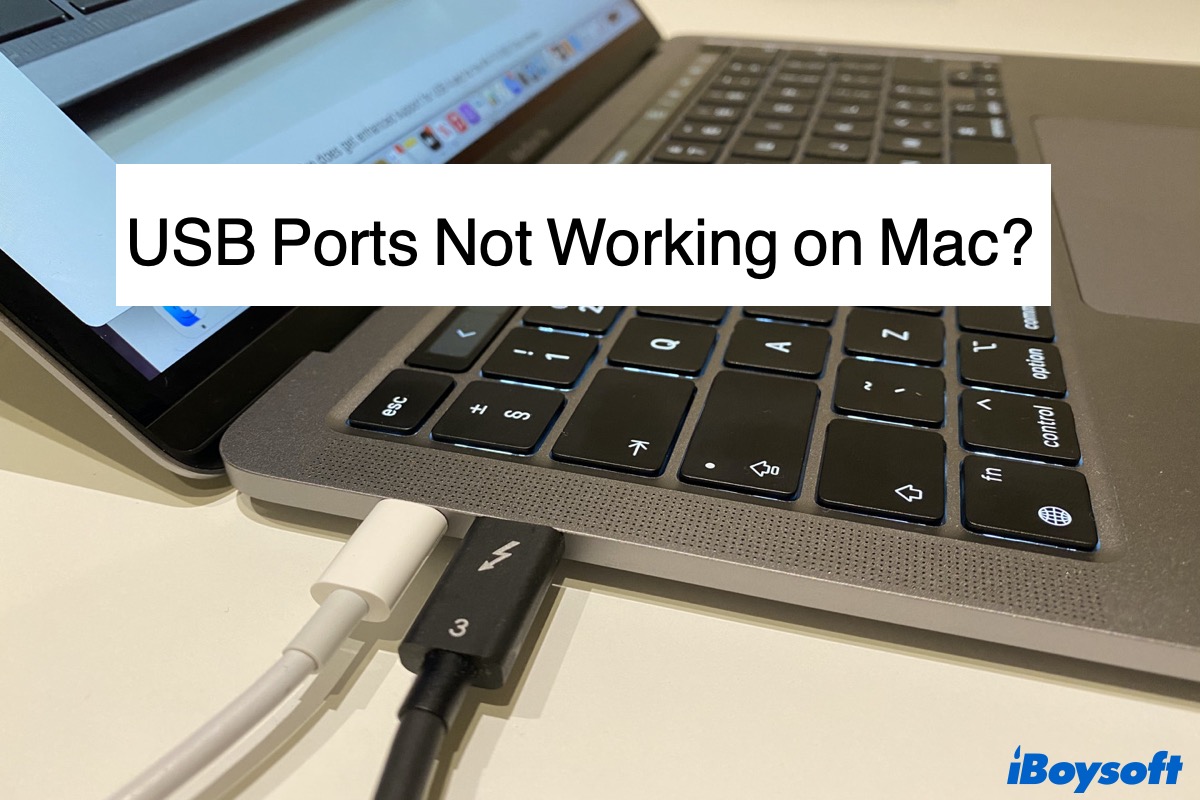The USB ports on your Mac are vital for connecting USB devices. But there are times when Mac can't read your USB devices due to USB ports not working. The good news is that it's often fixable. Let's start with some common reasons behind the USB problem.

Why are your USB ports not working?
MacBook Pro USB ports not working is more likely a software or cable issue than actual hardware failure. Here are some possible causes:
- Repeatedly insert and remove USB devices in a quick fashion
- Previously connected a faulty accessory to the Mac
- There is a virus interfering with the connection
- macOS update bugs
- Damages to the port
- Dirt or debris
When you can't access your USB devices on Mac, you may jump to the conclusion that the MacBook Air/MacBook Pro USB ports are not working. But this may not be the case. So we need to run some checks first.
How to fix USB ports not working on Mac desktop/MacBook Pro/MacBook Air?
Since loose connection or debris in the port will result in the USB ports not working on Mac, make sure the USB devices fit tightly in and the port is free of dirt. To ensure the USB port is clean, you can use a can of compressed air to blow the dust off or a toothpick to remove any obstruction.
You're also recommended to unplug other unnecessary USB devices to avoid the "USB Accessories Disabled. Unplug the accessory (or device) that is using too much power to re-enable USB devices." error.
Then troubleshoot the "MacBook USB ports not working" problem as the following:
First, check if it's a single port issue.
Try different USB ports on the Mac with the same device or use it on another computer. If another port works, the previous one is likely faulty, and you can decide to leave the port the way it is or repair it. If all USB ports are not working, the problem may reside in certain Mac bugs, the cable, or the device itself.
Second, test whether it's a cable issue.
If you don't have another spare cable, you can borrow one from friends or the Apple store, then try it with the same device to see if it works. If you use USB hubs to connect the device with Mac, swap to a different one or avoid using any and replace it with an Apple manufactured USB-C to USB-C cable if you have recently updated to macOS Monterey.
If the external hard drives or USB flash drives still won't show up on Mac, we need to repeat the test with a different device.
Third, look into the device.
Try connecting a different USB device to the Mac. If the new device works on your Mac, then the issue lies on the previous USB device. It's also likely that the inoperative device needs a driver update. Besides, you can seek help from the manufacturer or go for a reparation.
But before rushing to the repair shop, here are some useful things we can do if ports on another Mac work with the device in discussion, but your MacBook USB-C ports are not working.
Solution 1: Restart your Mac.
Sometimes, the USB port not working issue is caused by a minor glitch, which can be quickly solved by restarting your Mac. You can also boot into Safe Mode to isolate third-party software obstructing the USB device from working. If the MacBook Air USB ports not working problem still exists, we can reset the USB port.
Solution 2: Reset USB ports on Mac
To reset the USB ports on Mac, you need to open the built-in Terminal, enter the following command, and press Enter.sudo kextunload IOUSBMassStorageClass.kext
Then you need to reset the SMC to re-enable USB devices.
Solution 3: Reset the SMC
The SMC (System Management Controller) controls how your Mac's power is distributed to the USB ports. Therefore, resetting it will likely rectify the problem when one or all the USB port are not working.
The way to reset the SMC differs among Mac models. Here is how to do it on a MacBook, MacBook Air, and MacBook Pro:
- Shut down your Mac.
- Make sure your MacBook is connected with power.
- Press the Shift + Control + Option + power button simultaneously for a few seconds until the light on the power adapter changes color or blinks.
- Press the power button to turn on your Mac.
Now, you can plug a device into the USB port to see if it's functioning. If resetting the SMC didn't do the trick, move on to reset the NVRAM.
Solution 4: Reset the NVRAM
The NVRAM (Non-volatile random access memory) can fix MacBook Pro/MacBook Air/MacBook USB ports not working issue since it holds data about the USB components, keyboard, mouse, trackpad, etc. But bear in mind that you need to reset some settings such as date and time preferences after resetting the NVRAM.
If none of these works, check if you've missed a major macOS update that may help fix the unresponsive USB ports. If updating macOS still can't enable USB ports to work on your Mac, it's time to contact Apple support.
If you meet the USB port transferring slow problem, read related articles to find fixes: USB Port Slow Problem on Mac: Why and How to Fix?